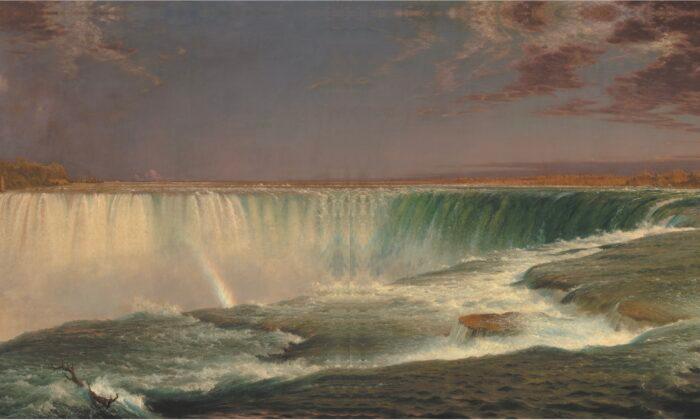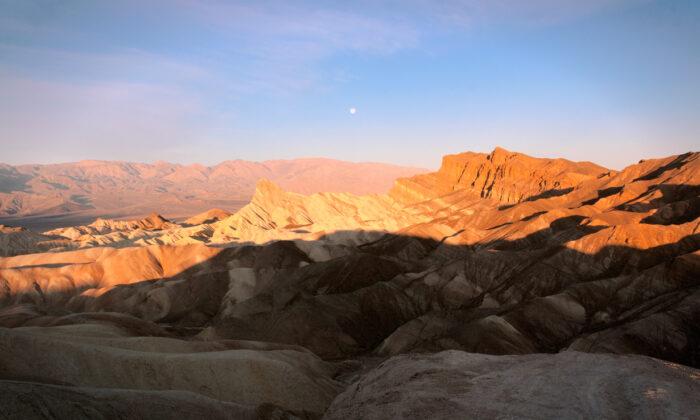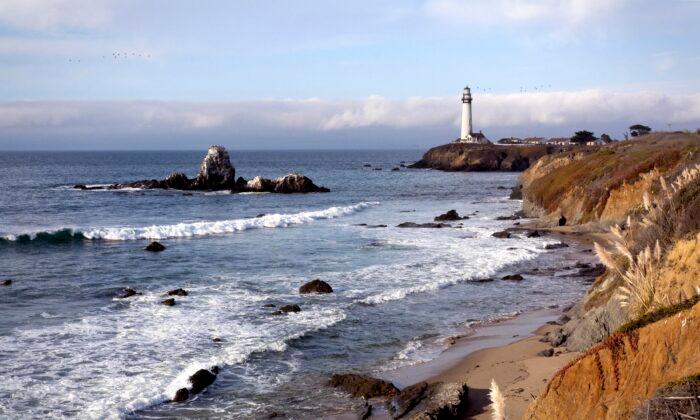“Their roar is around me. I am on the brink of the great waters—and their anthem voice goes up amid the rainbow and the mist.” —Excerpt from “Niagara,” Grenville Mellen, 1839
In the 19th century, realistically painted works of the Romantic period offered viewers in America, and across the Atlantic, the chance to glimpse the grandiosity of some of North America’s mightiest natural landmarks. Master painters such as Frederic Edwin Church chose spectacular sites such as Niagara Falls to depict the essential divinity inherent in the natural world.
America found a significant part of its young identity in these majestic places and the paintings that they inspired. Romanticist artists devoted themselves to capturing nature’s grandeur through the theatrically dramatic use of light, color, composition, and minute detail. In this noble effort, artists like Church sought not only to paint beautiful landscapes, but also to imbue their works with the sublimity of the Creator: the source who breathes life into the natural wonders the artists chose to depict.
Frederic Edwin Church, an American painter of the Hudson River School, was the first to capture the awe-inspiring scale and power of Niagara Falls. His large, horizontal canvas titled “Niagara” was a blockbuster hit of its day and was exhibited as a solo show in New York after its completion in 1857.

The Artistic Genius of Frederic Edwin Church
Church’s mastery is apparent in his thoughtfully designed compositions as well as in his exceptional attention to detail. Some visitors were said to bring binoculars in order to admire the finer details of his work, which truly invites close observation. Today, viewers can analyze the work in all of its incredible minutiae by visiting the National Gallery of Art in Washington, D.C., or by examining the high-resolution image displayed on the museum’s website.Stretched at a width of over 7 feet, the canvas’s significant dimensions allowed Church to encapsulate the wide bend of Horseshoe Falls and meticulously render the massive body of water and its surroundings.
“Niagara” gives the viewer the sensation of hovering above the river as it quickly roars toward the falls. Church’s brilliant decision to keep the river’s edge out of the picture plane fills the foreground of the painting with only water, rapids, and a tree trunk that is only milliseconds from plunging over the edge: a fitting way to represent one of the world’s greatest waterfalls. Church also lowered the foreground of the waterfall so that its details could be enjoyed from a slight aerial view while maintaining a more natural plane toward the middle of the painting.
A small strip of land separates water and sky, which is bathed in golden light. Beyond the distant water’s edge are easily overlooked, yet expertly rendered, elements of the natural landscape sprinkled with buildings and homesteads that are surprisingly imperceptible at first glance. The large sky is purposefully toned down to contrast the bright white foam of the falls, emerald blue highlights of water, and vivid glowing light of a fragmented rainbow.

Views for Americans and Canadians Alike
In 1867, Church completed another Niagara Falls masterpiece titled “Niagara Falls, from the American Side.” Church composed this canvas vertically from beyond the American and Bridal Veil waterfalls (Niagara Falls is a group of three waterfalls: Bridal Veil, American, and Horseshoe). The Canadian side of Horseshoe Falls is deep in the distance of the painting, allowing the artwork to encapsulate a viewpoint that is nearly opposite to his former painting, “Niagara.”In his depictions of Niagara Falls, Church opted to restore the area’s pristine views by removing most evidence of the tourist industry that was already experiencing swarms of people in the mid-19th century. Instead, he decided to include an imaginary and precarious-looking perch from which a very small figure peers over a railing into the cloud of mist below.
Water and trees at the left side of the painting are executed with hyper-realistic detail. They stand out sharply against the large area of foaming water and mist, which floats in a haze across most of the painting’s surface. This impressive sight is the result of hundreds of thousands of gallons of water falling every second at Niagara Falls. Church’s devotion to every detail of the scene’s rocks, water, and mist earned him high praise from critics and artists alike.
Danish Artist Paints America’s Beauty
Ferdinand Richardt journeyed to America from Denmark in 1855. During his initial four-year trip, he managed to create over 100 paintings of Niagara Falls and other American landscapes, cities, and landmarks. Like Church, Richardt visited Niagara Falls several times and produced many sketches and paintings of the natural wonder.
One of Richardt’s most well-known paintings of Niagara Falls is the appropriately titled “Underneath Niagara Falls.” Richardt’s painting provides us a glimpse of an experience of Niagara Falls that unfortunately no longer exists. In the 19th century, a natural rock area allowed people to stand beneath the falls until the cave area collapsed in the early 1900s. Still named the “Cave of the Winds,” visitors can experience the Bridal Veil and American Falls on foot from in front, but not underneath as the Danish-American artist depicted.
In Richardt’s painting, mist rises into illuminated clouds, and the waterfall, backlit by the sun, glimmers at its top edge. Water appears to surge downward from a source of light atop the cliff as the small figures stand vulnerably in its shadow below. The force of the water is made more apparent by the precarious stance of the two figures. Perched near the rock’s edge, they support each other while standing beside the wall of water that rushes down before them.
This great waterfall is a manifestation of natural divinity in the eyes of the Romanticists, filled with fearful and humbling power. These were places of great reverence—divine creations showcasing God’s masterwork. The landscape paintings became devotional, spiritual creations, which attempted to evoke the divine relationship among man, nature, and God.
Visitors to Niagara Falls are often moved to silence before the grandeur they have witnessed. Church and Richardt were similarly moved toward the difficult task of painting this sacred place, over and over. With skill and dedication, they sought to recreate its glory through the illusory portal of the canvas’s surface. With gratitude, countless people throughout the world have enjoyed these masterful works ever since.








